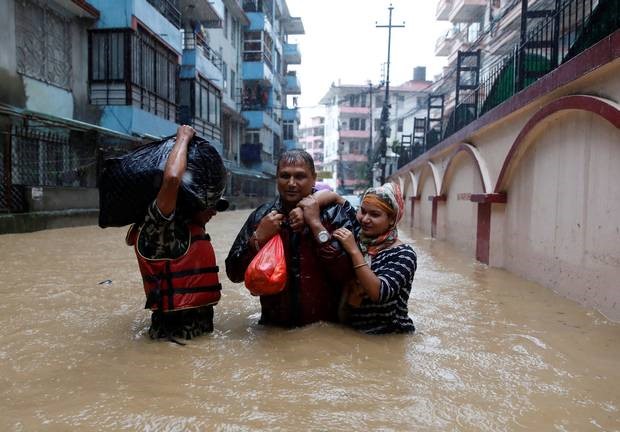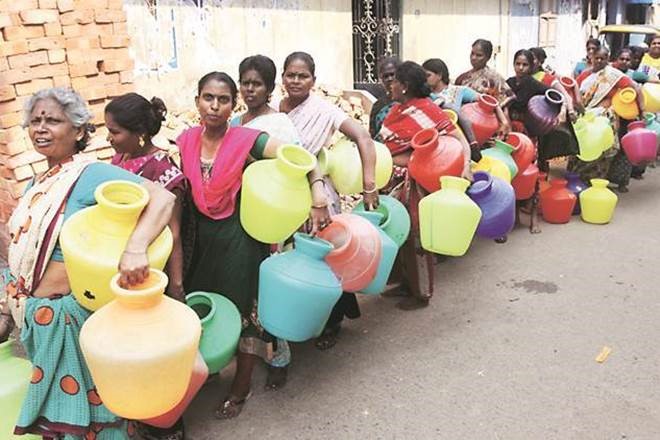The Indian sub-continent today enables us to see two terrible faces of climate change occurring simultaneously.
The first is Chennai on the south east coast. Chennai, formerly known as Madras, is a city of 7 million people and capital of the State of Tamil Nadu. Chennai has run out of water.
On 19 June Chennai city officials declared that ‘Day Zero’ when almost no water was left, had been reached as all four of the city’s reservoirs had run dry. This was the result of two years of deficient rainfall. The 2018 northeast monsoon season was one of the driest ever recorded in Chennai, as only 343.7 mm of rain fell compared to an average of 757.6 mm, which was a 55% rainfall deficit. Additionally, the entire state of Tamil Nadu had recorded a 23% rainfall deficit in that season.
Now tap water has stopped running and many people are relying on alternative water sources. Water tankers from areas of Tamil Nadu state unaffected by drought have been bringing water into some areas of the city. However, government tankers can take up to a month to appear after requested, so some families, wealthy residents, and business owners have opted to pay for costly private water tankers. The poor who live in slums do not have this option; a family in Chennai’s slums may receive as little as 30 litres (7.9 US gallons) of water every day compared to an average American household which uses 300 US gallons (1,100 litres) of water a day.
Many fights over water have also broken out as a result of the conflict. In one such conflict that occurred on 15 June 2019, a woman was stabbed.
The other face of climate change is seen both in the far north east of India where it borders with Nepal and in the Sunderbans region at the northern end of the Bay of Bengal.
This month massive monsoon flooding in India and Nepal has killed at least 90 people and displaced more than a million. July is usually the wettest month of the South Asian monsoon season but the flooding as been particularly extreme this year and, as is well know, more intense monsoons are a predicted and inevitable consequence of climate change.

To this must be added the fact that to be displaced in such poor societies, with almost no welfare system, is not the same as being displaced in Europe. It is to be thrown on to the already teeming streets with NOTHING in a way that will claim innumerable unrecorded victims.
The Sunderbans which means ‘beautiful forest’ is a vast mangrove forest and swamp at the confluence of three great rivers – the Ganges, the Brahmaputra and the Meghna. About 40% of it is in India and 60% in Bangladesh. It contains four protected areas listed as UNESCO World Heritage sites and is home to 4.5 million people and 453 fauna species including 290 bird, 120 fish, 42 mammal (most famously the Bengal Tiger), 35 reptile and eight amphibian species.

This rich and wonderful area was always going to be at risk from climate change and rising sea levels but the point is it is already being severely affected. Rapidly melting glaciers in the Himalayas increase the flow of water in the great rivers intensifying the threat from general rising sea levels. Warming oceans increase the intensity of monsoon cyclones which regularly strike the region.
A study in 2012 by the London Zoological Society reported that the Sunderbans coast was retreating 200 metres a year. Researches from the School of Oceanographic Studies, Jadavpur University, estimated the annual rise in sea level to be 8 millimetres (0.31 in) in 2010. It had doubled from 3.14 millimetres (0.124 in) recorded in 2000. The rising sea levels had also submerged around 7,500 hectares (19,000 acres) of forest areas. This, coupled with an around 1.5 °C (2.7 °F) rise in surface water temperatures and increased levels of salinity have posed a problem for the survival of the indigenous flora and fauna. The Sundari trees are exceptionally sensitive to salinity and are being threatened with extinction.
Loss of the mangrove forest will result in the loss of the protective biological shield against cyclones and tsunamis. This may put the surrounding coastal communities at high risk. Moreover, the submergence of land mass has already rendered up to 6,000 families homeless and around 70,000 people are immediately threatened with the same. This is causing the flight of the local population to the mainland, about 13% in the decade of 2000–2010. Many of these can be seen begging on the streets of Dhaka, the capital of Bangladesh.
Bear in mind that this once rich region, utterly devastated by centuries of British imperial plunder, is now one of the greatest concentrations of impoverished humanity on the face of the earth. Bangladesh with a population of 162 million in a country only a little larger than England is in 136th place in the United Nations Human Development Index.
These examples combine many of the features of the climate change catastrophe. Rising temperatures,drought and water shortages , warming seas and worsening storms and massive rainful, rising sea levels and flooding of people’s homes, and a devastating impact on the poor and forced migration and dramatically increasing species extinction. But the most important thing about them is that they are not a projection into the future; they are happening NOW.
Much of the talk (and hot air) about climate change has been couched in terms of the future, of projections about 2030, 2050 and the end of the century. In reality the famous predictions in the 2018 IPCC report giving the world 12 years to turn this round are already proving too conservative. This doesn’t mean we will all be dead in 12 years but it does mean that the intensification of extreme weather events has already begun and is going to increasingly threaten the livelihoods and lives of hundreds of millions of people , year on year from here on.
It is a real emergency and we need emergency action NOW.
Support the 20th September Global Climate Strike!












